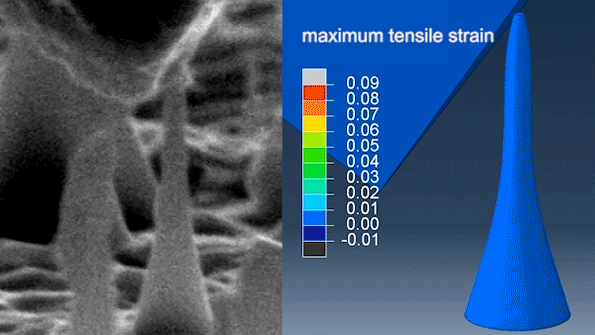Scientists Reveal How Diamonds Can Bend and Stretch
4 Years, 2 Months, 2 Weeks, 1 Day, 16 Hours, 43 Minutes ago

Diamond is well-known as the strongest of all natural materials, and with that strength comes another tightly linked property: brittleness. But now, an international team of researchers from MIT, Hong Kong, Singapore, and Korea has found that when grown in extremely tiny, needle-like shapes, diamond can bend and stretch, much like rubber, and snap back to its original shape.
The surprising finding is being reported this week in the journal Science, in a paper by senior author Ming Dao, a principal research scientist in MIT’s Department of Materials Science and Engineering; MIT postdoc Daniel Bernoulli; senior author Subra Suresh, former MIT dean of engineering and now president of Singapore’s Nanyang Technological University; graduate students Amit Banerjee and Hongti Zhang at City University of Hong Kong; and seven others from CUHK and institutions in Ulsan, South Korea.
The results, the researchers say, could open the door to a variety of diamond-based devices for applications such as sensing, data storage, actuation, biocompatible in vivo imaging, optoelectronics, and drug delivery. For example, diamond has been explored as a possible biocompatible carrier for delivering drugs into cancer cells.
The team showed that the narrow diamond needles, similar in shape to the rubber tips on the end of some toothbrushes but just a few hundred nanometers (billionths of a meter) across, could flex and stretch by as much as 9 percent without breaking, then return to their original configuration, Dao says.
Ordinary diamond in bulk form, Bernoulli says, has a limit of well below 1 percent stretch. “It was very surprising to see the amount of elastic deformation the nanoscale diamond could sustain,” he says.
“We developed a unique nanomechanical approach to precisely control and quantify the ultralarge elastic strain distributed in the nanodiamond samples,” says Yang Lu, senior co-author and associate professor of mechanical and biomedical engineering at CUHK. Putting crystalline materials such as diamond under ultralarge elastic strains, as happens when these pieces flex, can change their mechanical properties as well as thermal, optical, magnetic, electrical, electronic, and chemical reaction properties in significant ways, and could be used to design materials for specific applications through “elastic strain engineering,” the team says.